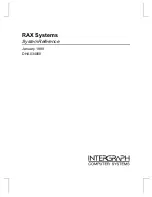
Appendix B
– BIOS & Setup
Dynatem
CPU-111-10 - Intel Xeon Quad-Core 6U VPX SBC – User’s Manual
32
detected.)
IDE0/Primary Master Primary
Master PATA drive or SATA mapping by the chipset, routed
to the backplane via J5.
IDE1/Primary Slave
Primary Slave PATA drive or SATA mapping by the chipset,
routed to the backplane via J5.
IDE2/Secondary Master
Secondary Master PATA drive or SATA mapping by the
chipset, routed to on-baord CompactFlash
IDE CDROM
First detected IDE CDROM.
USB Floppy Drive
First detected USB floppy drive.
USB Hard Drive
First detected USB hard drive.
USB CDROM Drive
First detected USB CDROM.
Enter Board Information Browser
Invoke HTML Browser on 0.HTM in ROM.
Enter BIOS Setup Screen
Invoke System Setup Utility in ROM.
Enter BIOS Debugger
Invoke BIOS debugger in ROM.
Reboot System
Restart system.
Power Off System
Invoke S5 state, powering off system.
PCI Slot [n]
Boot from device in PCI Slot ‘n’.
Network
Boot from any network adapter.
SCSI
Boot from external SCSI device (on PMC/XMC card).
Boot EFI Binary
Boot EFI kernel from ROM or disk, depending on the EFI
source setting in the Features menu. If disk is selected, then
the BIOS searches all the configured disks in the system in the
order they appear in the BBS list, attempting to load
EFILDR.BIN from the root directory in the FAT file system
located on those drives.
Boot Windows CE Image
Boot Windows CE kernel from disk. The BIOS searches all
the configured disks in the system in the order they appear in
the BBS list, attempting to load NK.BIN from the root
directory in the FAT file system located on those drives.
Boot Graphical Desktop
Boot Firmbase GUI supporting graphical Firmbase
applications as well as booting DOS in a graphical window.
For applications requiring instant-on functionality even when
the OS is not available or is still loading.
The photograph above shows a common setup of the BBS list for desktop applications. In this example, the first boot
device is theWestern Digital IDE hard drive (WDC WD800JB-00JJC0) connected to the target as a Primary Master
IDE drive. The second boot device is the Secondary Master and this is the on-board CompactFlash. The third device
is a USB Hard Drive. A fourth boot device, “None”, is a placeholder that is simply used to add more entries in the
setup screen; “None” is not actually executed by POST as a boot action item.
In addition to the BBS boot device list, there are two more sections in the BOOT menu; namely, the Floppy Drive
Configuration and IDE Drive Configuration sections. Both of these sections tell the BIOS what kind of equipment is
connected to the motherboard but
the floppy drive interface has not been implemented so please ignore this
and leave
it as “Not Installed”. Similarly, the IDE Drive Configuration section describes the type of hard drive equipment that
is connected to the motherboard, including the cable type. IDE drives, or actually more properly Parallel ATA
(PATA) drives, are connected to the motherboard with a flat cable with either 40 or 80 wires running in parallel
(hence, Parallel ATA, as opposed to Serial ATA.) The 40-pin connector supports speeds up to UDMA2, whereas 80-
pin cables are needed for higher transfer rates to eliminate noise. The BIOS can be told what type of cable is
available, so that it knows whether higher transfer rates are allowed; or, it can be told to autodetect the cable type, in
which case the drive and the motherboard must both support the hardware protocol used to autodetect the drive’s
cable type.


































